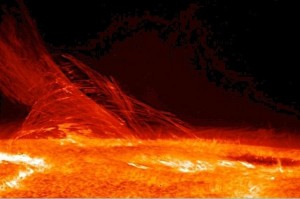What Will Happen When the Sun Burns Out
When the sun is about to exhaust its fuel, it will begin to swell, ultimately becoming large enough to swallow Earth. But the planet will be uninhabitable long before then, as the intensifying heat wreaks havoc across the globe.
A red-hot desert planet lies in ruins. Craters and grooves in its crust indicate that, many years ago, it was dominated by vast oceans, but they evaporated long ago, due to the heat from the nearby sun. The vapor from these dry oceans and lakes has generated an accelerating greenhouse effect, and now the only remaining signs of the globe’s once-abundant life are the die-hard bacteria clinging to life on the barren surface.
Welcome to Earth in 1.6 billion years. Even if we manage to avoid all the other threats to our existence, we will not escape the global warming caused by the sun’s expansion as it dies. And it will be much more extreme than most people can imagine.
 The planet’s ecosystems can only take so much heat. A warmer, moister climate will cause rocks to erode faster; this chemical disintegration will bind carbon dioxide in the atmosphere.
The planet’s ecosystems can only take so much heat. A warmer, moister climate will cause rocks to erode faster; this chemical disintegration will bind carbon dioxide in the atmosphere.
Because photosynthesis depends on having a certain amount of carbon dioxide in the air, in about 600 million years the first plants will begin to succumb. Without plants to produce food and oxygen, animals and humans will then die out.
Every 110 million years, the sun will shine brighter by 1 percent until, in about a billion years, Earth will become uninhabitable.
The sun will swell, then collapse
Beyond the life it supports, the planet itself will be affected by the sun’s death throes. Our yellow dwarf star is now in the prime of its life.
 At 4.6 billion years old, it generates massive amounts of energy each second as more than 600 million tons of hydrogen are converted into helium. A fraction of that energy reaches Earth in the form of sunlight, benefiting terrestrial life with heat and light.
At 4.6 billion years old, it generates massive amounts of energy each second as more than 600 million tons of hydrogen are converted into helium. A fraction of that energy reaches Earth in the form of sunlight, benefiting terrestrial life with heat and light.
But 7.6 billion years from now, the sun will begin to die: As the hydrogen fuel supply at its core runs out, gravity will force the core to contract, and the sun will begin to consume the hydrogen found in its shell. This will cause it to swell into a red giant. It will be 256 times larger than it is today and will shine 2,730 times more brightly. When this fuel runs out, the sun will begin to consume the helium at its core, eventually collapsing into an Earth-size white dwarf.
During this long process, the innermost planets, Mercury and Venus, will be swallowed by the giant sun, and Earth may well suffer the same fate. But first, the globe will boil as the temperature increases by several thousand degrees over millions of years. In the end, there will be nothing left on the planet — whatever doesn’t simply evaporate will be burned away, perhaps along with Earth itself.
Read also 29 Interesting Facts About The Sun
Escaping the exploding sun
 Once the sun enters its death throes, migrating to another planet could be an option. Assuming we’re still around millions of years from now, we should have had ample time to develop spacecraft that can evacuate the entire planet.
Once the sun enters its death throes, migrating to another planet could be an option. Assuming we’re still around millions of years from now, we should have had ample time to develop spacecraft that can evacuate the entire planet.
And even if we flew only as fast as one-tenth the speed of light, we could still reach several galaxies within a lifetime. Or we could buy ourselves a few billion extra years on Earth by moving it farther from the sun. U.S. astrophysicists have calculated that Earth’s orbit radius can be increased by changing the path of a comet so that it passes close by, transferring some of its energy to our globe and nudging us away from the sun.
The plan has significant risks, however — including inadvertently sending the comet into Earth.
